Looking for high‑quality PDF magazines to enjoy on the go? Or, maybe you want to create PDF content, embed the file in your site, and share it with readers. Approximately 28% of U.S. households subscribe to a digital magazine service, which offer improved reading experiences.
In this guide, we dive into all things PDF magazines.
We cover the pros and cons of this content format, whether or not you should create a PDF magazine or a digital magazine, and the best platforms—no matter what you’re looking for.
Keep reading for our top tool picks for reading and creating PDF magazines and for converting PDF files into mobile‑optimized magazines that are easier to read on small devices.
What is a PDF magazine?
A PDF magazine is a digital publication distributed as a Portable Document Format (PDF). This a file format was created by Adobe to protect the formatting, fonts, and images and of a document, making it a good fit for distributing highly visual content like magazines, brochures, catalogs, reports, and other publications electronically.
A PDF magazine usually looks exactly like a print magazine and might include articles, images, and advertisements. PDF magazines can be easily viewed on various devices, including computers, tablets, and smartphones, using PDF reader software.
Publishers opt for a PDF format because it provides a consistent and reliable way to present content across different devices while maintaining the intended layout and design. Readers can download the PDF file, making it a good option for offline reading.
Use cases
PDF magazines are versatile and can be distributed in a variety of ways:
- As an email attachment to subscribers
- Linked from a CTA button in email campaigns
- Embedded directly on your website using a PDF viewer
- Offered as a paid digital product or subscription
- Used as a gated lead magnet to support content marketing
Pros
PDF magazines are extremely easy to create, especially if you’re already producing a print edition. You can export the print file as a PDF and publish it online without needing any additional software. Tools like Canva, Adobe InDesign, and Marq make it fast to design high-quality, multi-page content. Plus, PDFs are compatible with virtually every device and operating system, and can be downloaded for offline reading.
Cons
PDF magazines are not optimized for mobile reading. On small screens, users are forced to pinch and zoom to read the text, which leads to a poor user experience. Even on desktop, the multi-column layout can be difficult to follow. PDFs are also static, so they don’t support interactive features, adaptive design, or accessibility options like audio narration—unlike true digital magazines.
PDF magazines versus digital magazines
A PDF is a static document. Once created, it will have the same colors, fonts, and layout on any device and any screen size. This is not necessarily a benefit, however, because PDF files aren’t mobile-optimized. The text stays in the column and layout instead of filling the available space.
A digital magazine, on the other hand, is mobile optimized, much like a modern website, and can fill the available space with a single column of content.
PDF magazine example
Check out this example of a PDF travel magazine. As you can see, the content is not optimized for reading online. Readers need to use the zoom tool to make the font larger.

Digital magazine example
Now, compare that PDF magazine example to this example of a digital magazine created with eMagazines.
As you can see, eMagazines’ technology reflows the PDF content from Time Traveler into a clean, single-column view that is readable on any device.
Audio articles can be automatically added using AI.

3 platforms for reading PDF magazines
To read PDF magazines online, you can navigate to a website that offers multiple magazines or download their native apps.
The following platforms allow you to access millions of PDF magazines in one place.
1. FlipHTML5
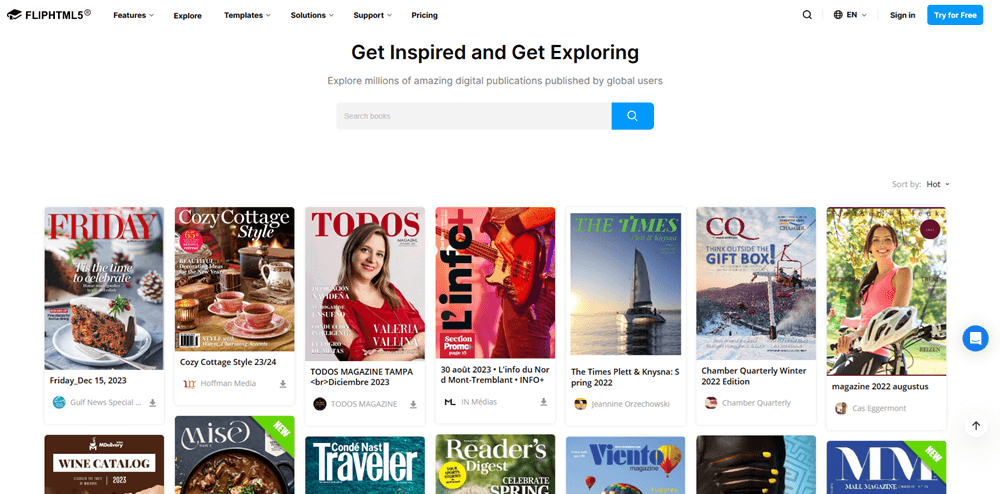
FlipHTML5 is a PDF magazine embedding platform that offers an Explore tab for readers. Here, you can find millions of digital publications created by their global user base, allowing you to find all sorts of great free content.
Pricing:
FlipHTML5 offers four pricing tiers. The Free plan includes 5 flipbooks per day and limited customization. The Pro plan is $12.40/month (billed annually) and unlocks unlimited flipbooks, no ads, and branding options. Platinum is $24.90/month and adds interactivity and multiple accounts. The Enterprise plan is $83.30/month with advanced features, API access, and 10 user accounts.
2. Anyflip
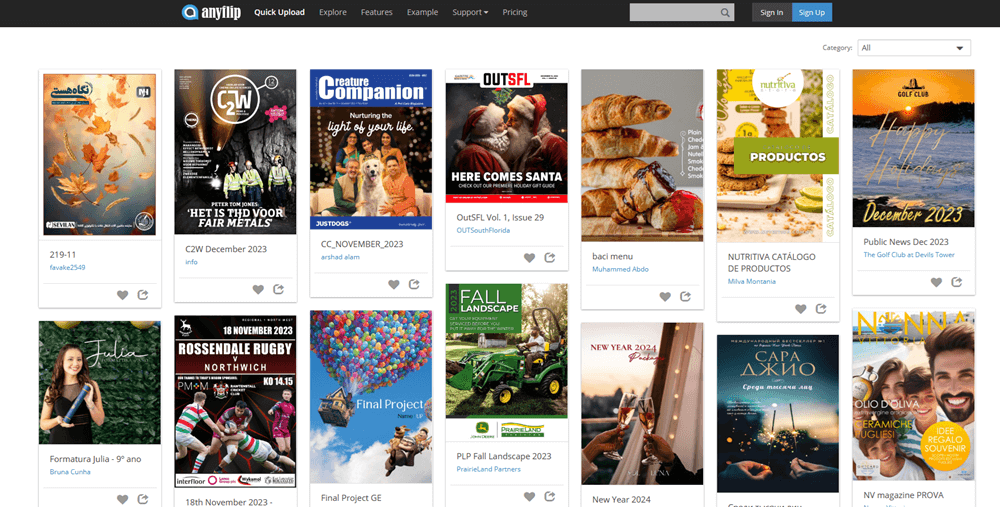
Similar to FlipHTML5, Anyflip is an online platform for sharing and embedding PDF content. You can head over to their Explore tab to find free PDF magazines across all categories and in dozens of different languages.
Pricing:
AnyFlip offers four subscription tiers. The Free plan provides basic PDF‑to‑flipbook conversion with watermarks. The Pro plan costs $13.08/month (billed annually) and removes ads, adds branding, and supports 60 uploads per day. The Platinum plan is $26.17/month, adding interactivity, custom domains, and 3 user accounts. The Enterprise plan is $87.42/month with 10 accounts, API access, and unlimited uploads.
3. Flipboard
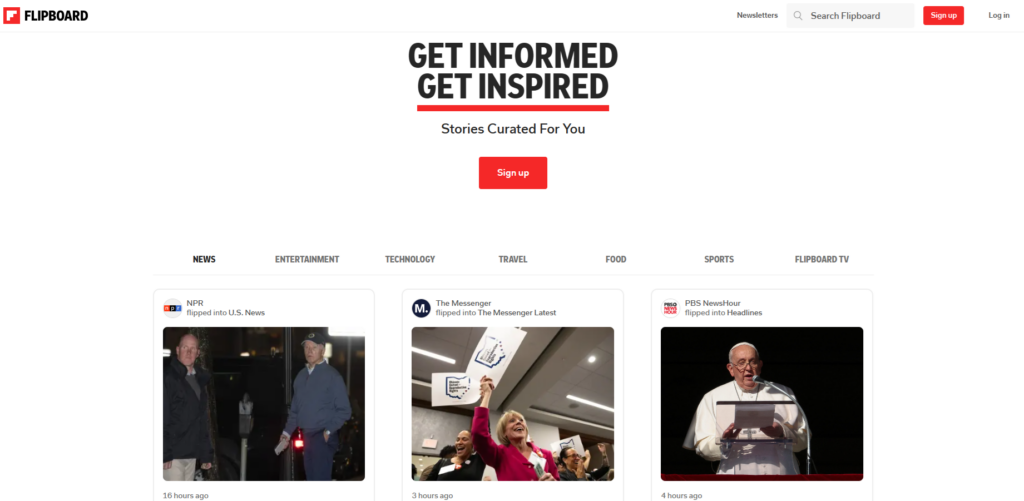
With Flipboard, you can read online magazines and curated stories. You can also curate your own digital magazine by adding stories to your feed. Many articles are in a digital, mobile-optimized format, while some are PDF files that have been uploaded for online reading.
Pricing:
Flipboard is completely free to use. The platform generates revenue through advertising rather than subscriptions, allowing users to access curated news, magazine articles, and topic-based feeds without cost. Expect to see occasional full-page ads while browsing and reading within the app.
3 tools for creating PDF magazines
Do you want to create your own PDF magazine?
You’ll need to use a graphic design platform to create the layout and add your content. Below, we’ve got options for any experience level.
1. Adobe InDesign

Adobe InDesign is the premier graphic design tool for magazine creation. Use it to design a stunning cover and craft every page. There are professional templates to choose from, or you can design from scratch. Keep in mind that InDesign was developed for professional graphic designers, and it’s too complex for non-professional use.
Pricing:
Adobe offers multiple plans for teams. The Creative Cloud Single App plan for InDesign starts at $37.99/month per license (billed annually). For access to over 20 apps including InDesign, Acrobat Pro, Photoshop, and Adobe Firefly, the Creative Cloud Pro plan is $99.99/month per license. Volume discounts and administrative tools are included for business teams.
2. Canva
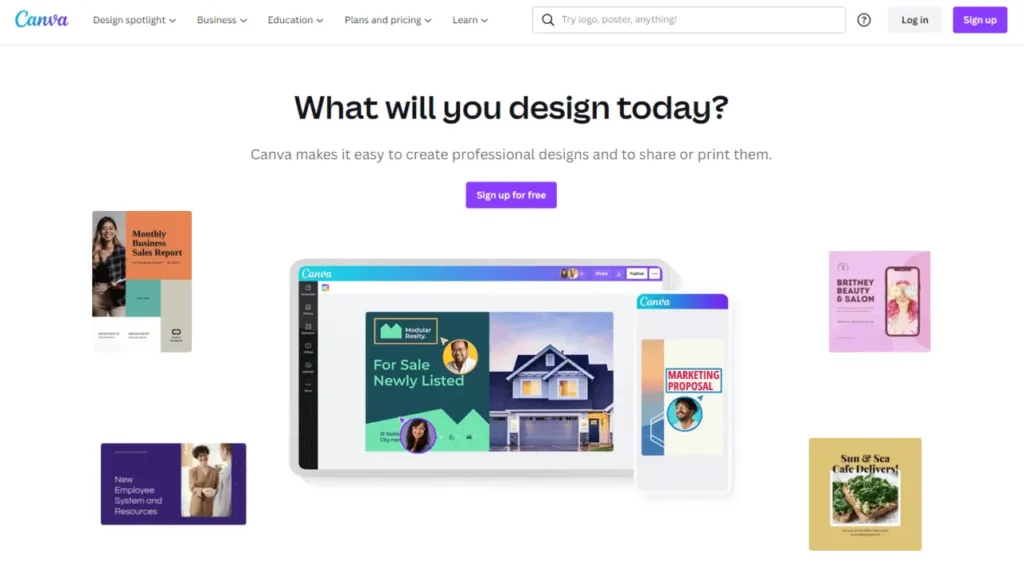
Canva is the most popular online graphic design platform for non-professional designers. There are thousands of easy-to-use templates, including magazine covers, magazine tables of content, and magazine pages. You can add multiple pages and then export your design as a single PDF file.
Pricing:
Canva offers a free tier, plus paid subscriptions suited to publishers and teams. The Pro plan (for individuals) is $119.99/year per user (or approx. $12.99/month). The Teams plan supports collaborative workflows and centralized brand assets, starting around $100–150/year per user when billed annually. Large teams must contact sales for custom pricing.
3. Marq

Marq is another great option for creating a PDF magazine if you’re not a pro designer. They offer a brand templating platform that makes it easy to create more editions and special issues without having to work from scratch every time.
Pricing:
Marq offers a free plan for individuals with limited features, while paid plans start at $10 per user per month, billed annually. Team plans include a second free license and offer automation and collaboration features. Enterprise plans are available with custom pricing for organizations needing advanced customization, integrations, and unlimited storage.
3 platforms for embedding your PDF magazine in your website
If you want to share your PDF magazine with readers online, the next step is to embed it in your website.
This makes it a little easier to read because users have the option to enter full-screen mode, use the zoom tool, and click the arrows to move through the pages.
Check out these popular options.
1. Publuu
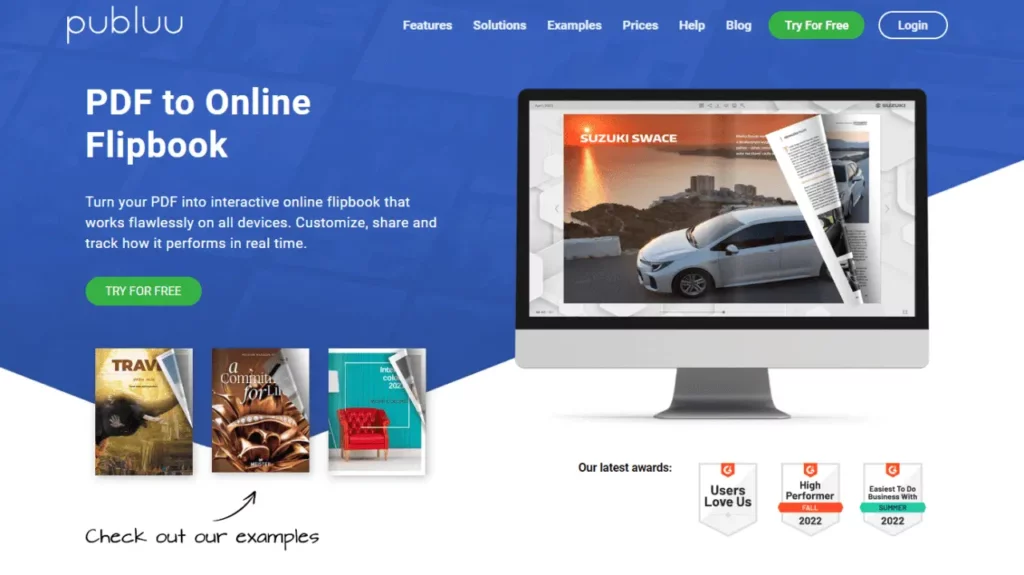
Publuu takes your PDF file and turns it into an interactive flipbook. You also get viewing analytics to help you discover which content is the most popular. And there are sharing tools for social media and email marketing.
Pricing:
2. Issuu
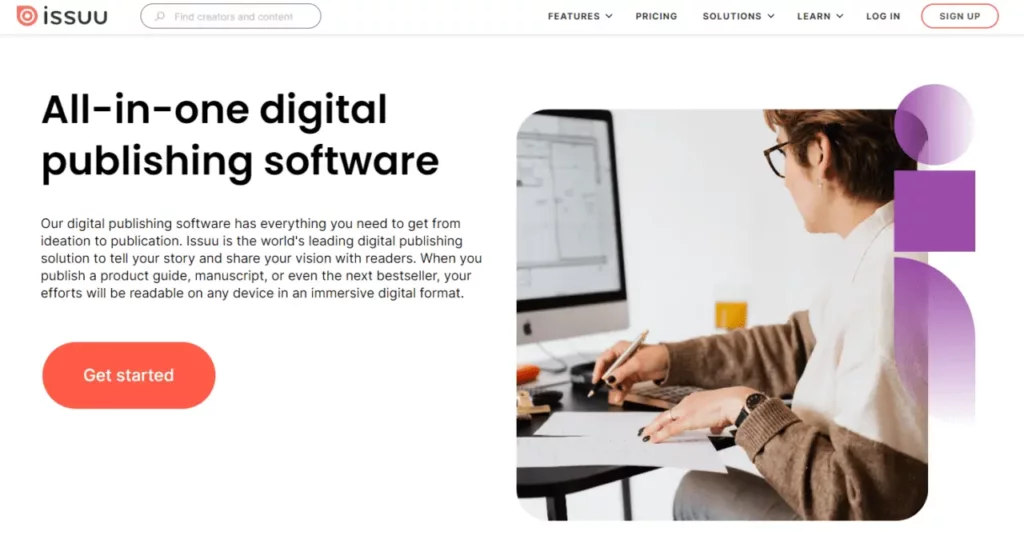
Issuu is another option for PDF embedding. You can convert your PDF magazine files into flipbooks, social media posts, articles, and GIFs, making this a comprehensive platform for content promotion.
Pricing:
Issuu offers multiple plans. The Starter plan is $21/month (billed annually) with basic flipbook features. The Unlimited plan, at $188/month, adds branding, analytics, and lead generation. Issuu for Teams starts at $417/month and includes multi-user support, private workspaces, and advanced content management. A limited free plan is also available.
3. FlowPaper
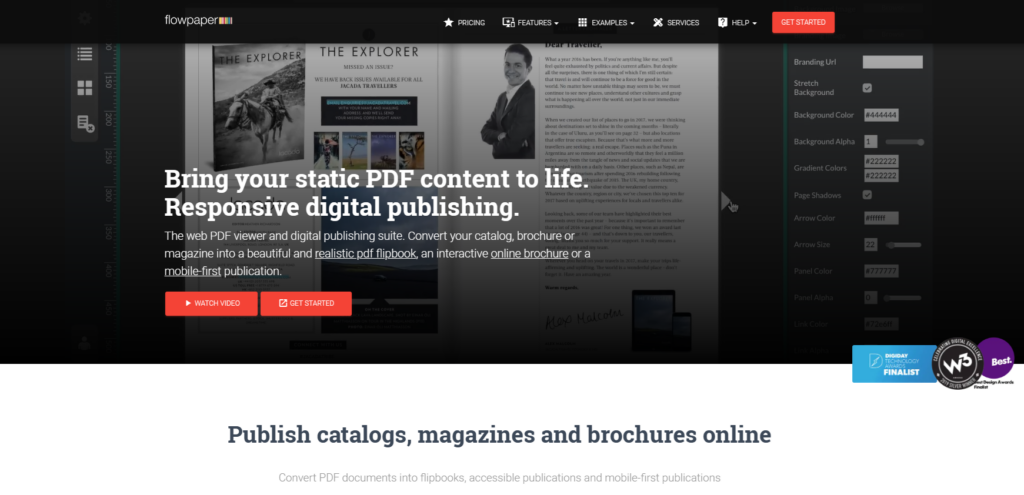
With FlowPaper, you can turn any PDF magazine, catalog, or brochure into a realistic PDF flipbook that is can embedded on any page of your website. The platform comes with Google-friendly content crawling and indexing to increase your chances of ranking your PDF magazine for important keyphrases.
Pricing:
3 platforms for converting PDF magazines into mobile-optimized digital magazines
As shown in the digital magazine example above,
1. eMagazines
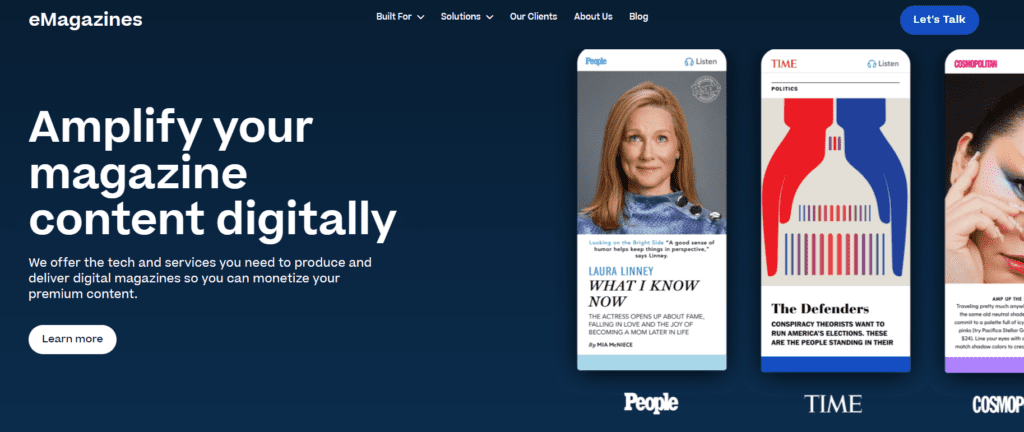
eMagazines is a trusted solution for creating mobile-optimized digital magazines. Our platform converts the PDF file from your print version into a beautiful online magazine with clean design, on-brand fonts and colors, and single-column content that is a breeze to read. We also offer all of the services you need to create, distribute, and promote the digital edition of your magazine, with no need for mobile apps or user passwords.
Pricing:
eMagazines offers custom pricing based on your needs. They provide flexible plans for national and niche publishers alike, covering production, mobile optimization, article audio, Apple News+ distribution, customer acquisition, and more. Contact the team for a tailored quote that fits your digital publishing goals.
2. MagLoft
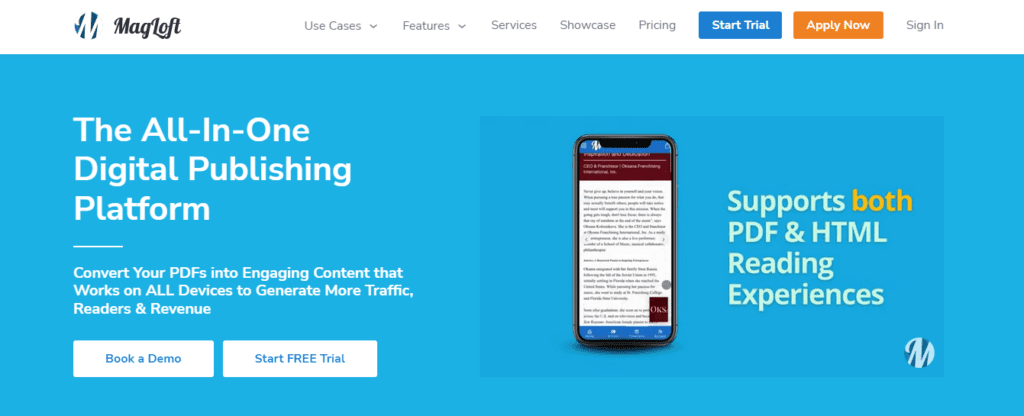
MagLoft is a digital publishing platform designed to seamlessly transform traditional PDF magazines into digital editions. The platform offers a PDF converter, mobile app and website management tools, a content editor, and customer relationship management (CRM) capabilities.
Pricing:
MagLoft’s Starter plan is $199/month and includes a Progressive Web App and basic features. The Professional plan, at $499/month, supports iOS/Android apps, tiered subscriptions, and social media publishing. The Tech Studio plan is fully custom, offering enterprise-grade solutions for high-volume digital publishers.
3. Mag+

Mag+ is a magazine publishing solution offering tools to create, manage, and publish interactive content. Features include multichannel publishing, interactive content creation, content management system, performance tracking, and monetization analytics.
Pricing:
Mag+ does not publish pricing on its website. Instead, both its platforms—Designd (for app publishing) and Now (for multichannel content management)—require you to request a custom quote. Each plan is tailored based on your specific content, publishing needs, and team size.
Frequently asked questions
What file size and resolution work best when exporting a PDF magazine for online readers?
For online reading, aim for a file size under 10MB to ensure fast loading. Export images at 150–200 DPI for a balance between quality and performance. Use web-optimized settings when exporting your PDF, and compress fonts and images to keep the layout intact without slowing down the user experience.
How can I make my PDF magazine more interactive or engaging for digital audiences?
The best way to make your PDF magazine more interactive is to convert it into a digital magazine format. This allows you to add features like a clickable table of contents, audio versions of each article, and responsive text that automatically adjusts to any screen size for a smoother reading experience.
Which tools make it easiest to convert a PDF magazine into a mobile‑friendly format?
The easiest tools to convert a PDF magazine into a mobile-friendly format are eMagazines, MagLoft, and Mag+. These platforms take your existing PDF and reflow the content into responsive, single-column layouts that are optimized for smartphones and tablets, making your magazine easier to read on any device.
Are PDF magazines good for SEO, or should I use another format for better search visibility?
No, PDF magazines are not ideal for SEO. Search engines have limited ability to crawl and index content inside PDF files, especially when the text is embedded in images. For better search visibility, it’s recommended to use HTML-based digital magazine formats that allow for structured content, metadata, and mobile responsiveness.
What’s the best way to distribute a PDF magazine securely while still encouraging sharing?
Use gated downloads or password-protected links to control access, and embed your PDF in a web viewer. This allows sharing the viewing experience without giving away the raw file.
If you’re ready to create the best possible reading experience, then check out eMagazines.



